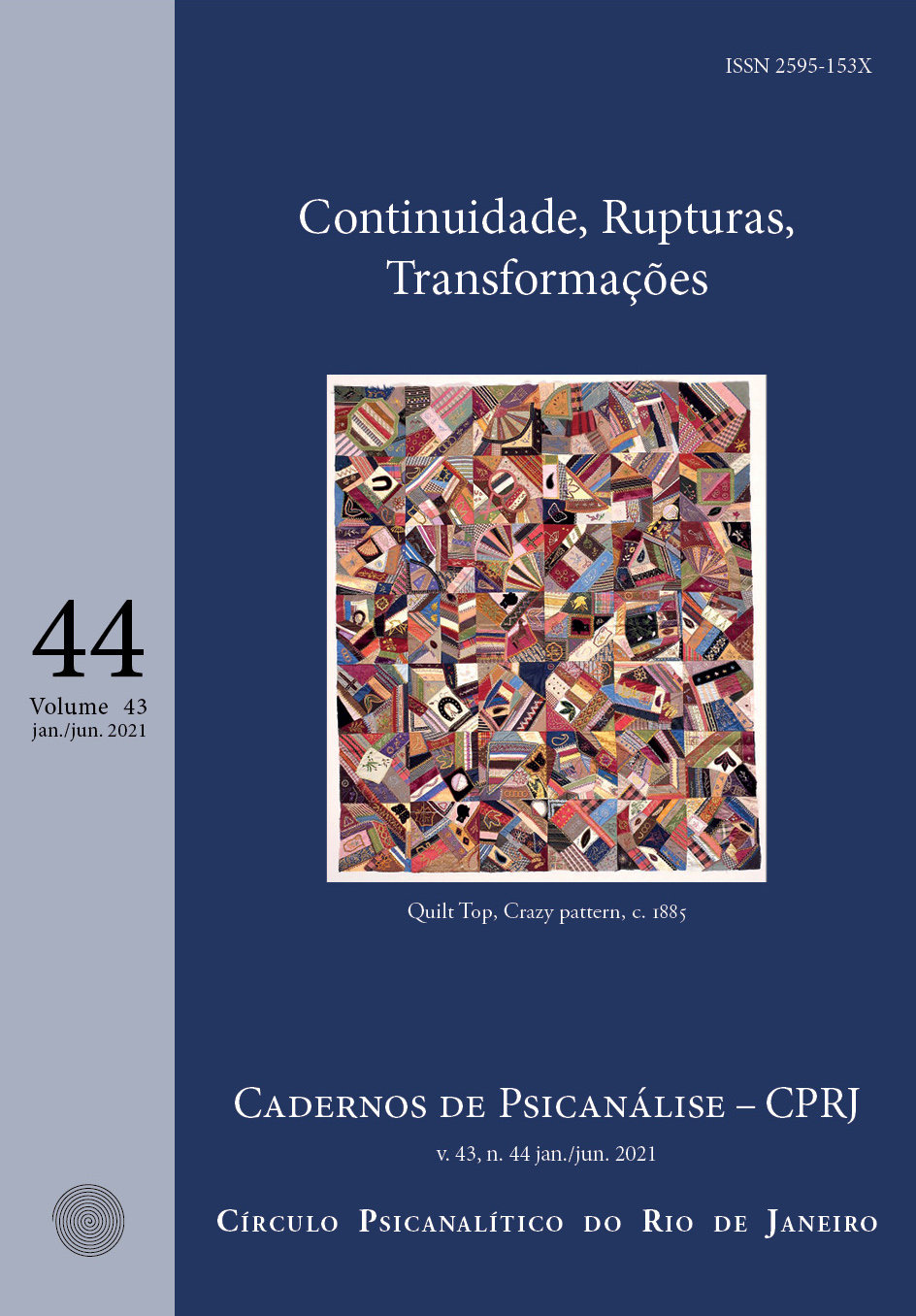Transformação e invariância
Em continuidade ao pensamento de Bion
Resumo
A partir das noções de Bion relativas à transformação, à função alfa e à cesura, o artigo trata da ligação entre a invariância e a transformação, nos processos de representação e no pensamento, propondo que a invariância tem por função atenuar os efeitos difíceis das mudanças, que eventualmente podem ser experimentadas como catastróficas. Essa função permitiria construir uma representação e assegurar uma continuidade, tendo como eixo a ritmicidade que permite a integração das experiências de separação ou de transformação pressupostas na passagem de um estado a outro. A noção de invariante é útil igualmente para pensar a continuidade nos movimentos de descontinuidade, de ruptura, que o trabalho de pensamento necessita para a construção de abstrações.
Referências
ALVAREZ, A. (1992), Une présence bien vivante, trad. fr. Larmor-Plage: Éditions du Hublot, 1997.
ANZIEU, D. (1979), « La démarche de l’analyse transitionnelle en psychanalyse individuelle », in Kaës (dir.), Crise, Rupture et Dépassement. Paris: Dunod, p. 184-219
BION, W.R. (1962), Aux sources de l’expérience, trad. fr. Paris: PUF, 1979.
________ (1965) Transformations. Passage de l’apprentissage à la croissance, trad. fr. Paris: PUF, 1982.
________ (1966), « Catastrophic change », Scientific Bulletin of the British psychoanalytical society, n° 5, publication interne.
________ (1967), Réflexion faite, trad. fr.. Paris: PUF, 1983.
________ (1970), L’Attention et l’Interprétation, trad. fr. Paris: Payot, 1974.
________ (1975a), « Césure », trad. fr., in: Entretiens psychanalytiques, Paris, Gallimard, 1980, p. 241-259.
________ (1975b), Le Rève, trad. fr., in: Un mémoire du temps à venir. Larmor-Plage: Éditions du Hublot, 2010, p. 1-189.
________ (1978), Quatre discussions avec Bion, trad. fr. Paris: Ithaque, 2006.
CICCONE, A. (2014), La Psychanalyse à l’épreuve du bébé. Fondements de la position clinique, nouvelle édition augmentée. Paris: Dunod.
________ (2016), « Rythme et bisensualité psychique », in: AMY et al., Autismes : spécificités des pratiques psychanalytiques. Autismes et psychanalyses - II, Toulouse: Érès, p. 75-95.
________ et al. (2018), Aux frontières de la psychanalyse. Soin psychique et transdisciplinarité. Paris: Dunod.
KAËS, R. (1979), « Introduction à l’analyse transitionnelle », in KAËS (dir.), Crise, Rupture et Dépassement. Paris: Dunod, p. 1-81.
KEATS, J. (1817), « Lettre à ses frères Georges et Tom », trad. fr., in: ________Lettres . Paris: Belin, 2010, p. 76.
KLEIN, É. (2016), Le pays qu’habitait Albert Einstein. Arles: Actes Sud.
RESNIK, S. (1994), Espace mental, trad. fr. Toulouse: Érès.
SEGAL, H. (1981), Délire et Créativité, trad. fr. Paris: Éditions des Femmes, 1987.
STERN, D.N. (1993), « L’"enveloppe prénarrative". Vers une unité fondamentale d’expérience permettant d’explorer la réalité psychique du bébé », trad. fr. Journal de la psychanalyse de l’enfant, n° 14, p. 13-65.
TUSTIN, F. (1981), Les États autistiques chez l’enfant, trad. fr. Paris: Le Seuil, 1986.
Copyright (c) 2021 Cadernos de Psicanálise | CPRJ

This work is licensed under a Creative Commons Attribution-NonCommercial 4.0 International License.




